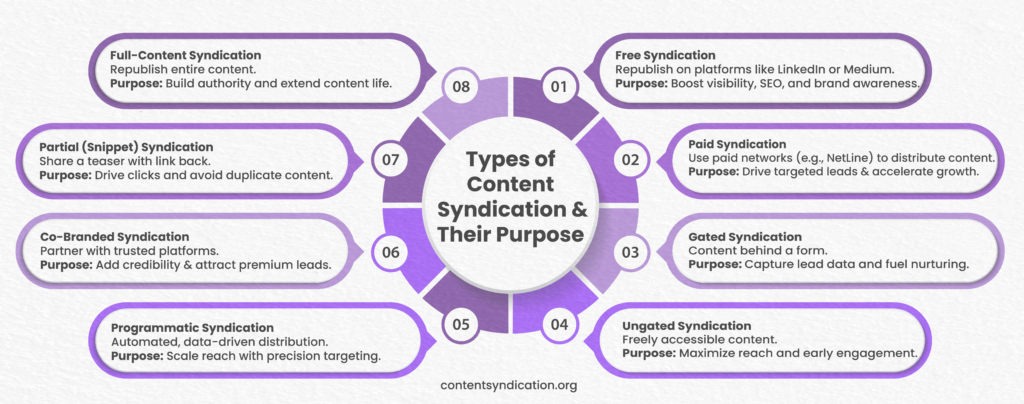Every marketer wants more leads within a limited budget. That’s where B2B Content Syndication Marketing becomes a game-changer, helping you to increase the number of leads without added time and budget of effort of creating new content.
It puts your existing content in front of more of the right eyes, increasing content’s reach and audience. Not the random audience, but the audience who are already engaging with content like yours.
So, how can you increase the effectiveness and draw more eyes for your product or services? This blog has the answer. Let’s look at how you can increase web traffic, generate leads, and convert them into measurable revenue.
What is B2B Content Syndication Marketing?
Many marketers confuse content syndication with guest blogging or duplicate content. Many marketers hesitate due to concerns about SEO penalties. Adding to that, jargon like “canonical tags” and “gated content” only adds to the confusion.
In reality, B2B content syndication marketing is the strategic republishing such as blogs, whitepapers, or webinars on trusted third-party platforms to reach a broader, relevant audience.
Think of it as recycling your best content to extend its shelf life. When done right, it boosts brand awareness and drives lead generation — all without compromising your SEO.
How does it avoid damaging SEO? By using canonical tags and proper attribution, you clearly signal to search engines where the original version of the content resides.
In other words, it’s like putting your best content in front of an active audience instead of waiting for people to stumble upon your website.
Why is Content Syndication Important in B2B Marketing?
Creating valuable content — great start. But are you making sure it’s reaching the right audience? That’s one of the most common frustrations for B2B marketers. Your content might perform well internally, but if it lacks external visibility, it’s not fulfilling its true purpose.
This gap often exists because decision-makers are consuming content long before they reach out to sales. And if your content isn’t present during those crucial research stages, you’re already out of the picture.
Benefits of B2B Content Syndication Marketing
High customer acquisition costs and poor lead quality are challenges most marketers face. Isn’t that, right? You might be spending a decent budget on paid campaigns to get clicks, but not conversions. So how does content syndication help?
When you place your gated assets (like whitepapers or webinars) on curated networks, you can capture high-intent leads at a lower cost. These leads often match your ideal customer profile (ICP) and have opted in to access your content.
On top of that, appearing on reputable platforms builds brand credibility, improves content ROI, and brings qualified traffic to your funnel — without the high cost of traditional paid channels.
That’s a compelling reason to make syndication a core part of your content strategy.
Types of Content to Syndicate in B2B

Not every asset is equally effective for syndication. The best-performing content includes. Should it be your latest blog post? A case study? A product video?
Focus on evergreen, educational, and actionable content—think whitepapers, research reports, webinars, and in-depth guides.
Why? Because these formats consistently align with what B2B buyers are actively searching for during their decision-making process.
According to the Content Marketing Institute (2024), 74% of B2B marketers say content marketing has helped them generate demand or leads.
Yet much of this content doesn’t get the exposure it deserves. Syndication allows the best assets to reach the right people at the right time.
Don’t have enough of that content? No problem. Repurpose what you have. Turn blogs into eBooks, webinars into reports, or customer interviews into case studies.
The key is to match the content format to the funnel stage and buyer intent.
Infact, 65% of marketers say content syndication is their most effective tactic for top-funnel awareness. Syndication isn’t just a distribution method. It’s a high-impact engine for lead generation and brand positioning.
Best Practices for B2B Content Syndication Marketing
Launching a campaign without clear goals is a recipe for wasted budget. Follow these practices to ensure success.
The best way to prevent this?
- Define what success looks like—lead generation, brand visibility, SEO lift, or all of the above.
- Choose platforms that match your ICP based on industry, role, and geography.
- Use tracking links and UTMs to monitor campaign performance.
- Don’t forget to measure key metrics like MQL rate, engagement, and bounce rate—and keep optimizing as you go.
A well-structured campaign can deliver a consistent pipeline of qualified leads. Just remember; treat it like a performance channel, not a “set it and forget it” tactic.
How to Start a Content Syndication Campaign for Your B2B Business
Feeling overwhelmed? Break it into steps:
To simplify:
- Start with a content audit—identify what’s ready to syndicate.
- Define your ideal customer profile (ICP) and campaign goals.
- Choose platforms that fit those goals and decide whether to gate the content.
- Set up tracking, analytics, and CRM workflows before launch.
- Start small with a pilot campaign. Learn, optimize, and scale.
In Conclusion
B2B Content Syndication Marketing isn’t just a buzzword—it’s one of the most effective channels for demand generation. Without a doubt, it is an effective channel for B2B demand generation.
But like any strategy, it needs intention, alignment, and execution. Don’t let your best content lose its spark. Give it the reach it deserves. When placed in the right arena, your content can transform visibility into leads and leads into revenue.




